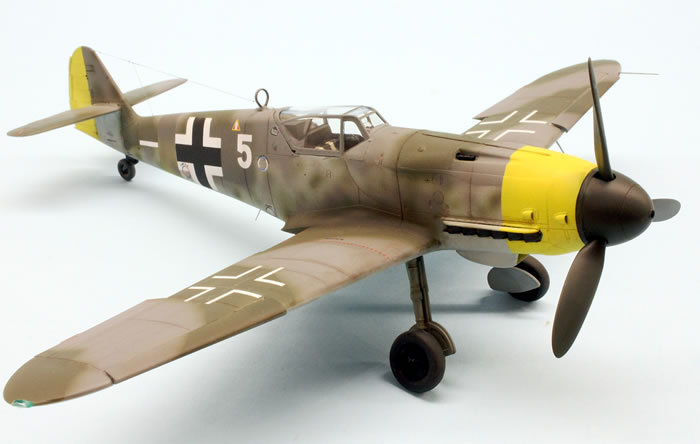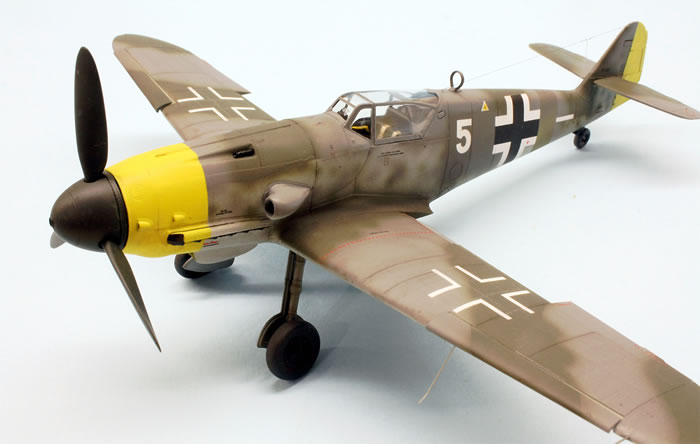Eduard's 1/48 scale
Messerschmitt Bf 109 G-10
by Roland Sachsenhofer
|
Messerschmitt Bf 109 G-10, W.Nr. 611048 |

Background
The Bf 109 is the most produced aircraft in history - and it will probably not have to relinquish this rank in view of the ever increasing performance of the individual fighter aircraft. With the production of more than 33,000 Bf 109s over a period of about ten years, it is not surprising that the histories of the individual sub-versions sometimes resemble those of their own successful fighter designs.
The models of the G version shown here undoubtedly represent one of the most significant and highly differentiated branches that developed from the solid stem of the early B, D, E and of course the closely related F variants.
To illustrate this point: the "Gustav", with an incredible 25,000 aircraft built, represents about 70 percent of all Bf 109s ever produced. Starting in the summer of 1942, it began to replace the preceding Bf 109F, and the "Gustav" then remained in production until the end of the war.

As already mentioned, the G-version was divided into numerous sub-variants. In the last three years of the war, in an attempt not to lose touch with the ever-increasing power spectrum of enemy aircraft, all the energy and resourcefulness that could still be extracted from the slowly ageing basic design was put into it. It is remarkable that they succeeded: until the end of the war, Messerschmitt's 109 remained a deadly opponent in the hands of experienced pilots, and its reputation as one of the best fighters of its time was justified even in the spring of 1945. This could only be achieved with a series of fundamental changes to the design.
Firstly, this concerned the engine: while the DB 601E of the Bf 109F still delivered 1350 hp to the propeller, the DB 605A or B of the Gustav increased the power to 1435 horsepower. This meant a top speed of 685km/h at high altitude for the G-10, a speed with which the 109 could again catch up with the absolute top of fighter development. In addition, from the G-10 and its new DB 605D engine, water/methanol injection was available: for a short time, this -not exactly engine-friendly- measure increased power to 1800 hp.
The armament also became more powerful with the G-version, at least by an order of magnitude. In the "Gustav", the two fuselage-mounted 7.92 mm MG 17s of the previous versions were replaced by large-calibre 13 mm MG 131s. The 20 mm MG 151 gun firing through the propeller scar was retained. However: from 1943 onwards, the Mk 108 machine gun was also available for the engine guns, and was fitted to the sub-variants known as /U4. With this impressive 30mm calibre weapon, it only took three hits on average to bring down a heavy bomber.

But that was not all: the "Bf 109G" could be converted into a "gunboat" by means of an armament kit. Two more MG 151s or MK 108s were carried in nacelles under the wings.
Thirdly, the airframe was revised. Aerodynamically, the Gustav had to contend with an increase in weight caused by the measures described above: the more powerful engine not only brought considerably more weight to the scales, but also required structural reinforcements on the airframe due to the enormous torque, which drove the weight even higher. The weight made a more massive chassis with larger diameter tyres necessary. The larger wheels in turn caused troublesome bulges on the top of the wing. Bulges also became typical for the G for another reason: two more bulges in front of the canopy were caused by the larger space requirements of the new Mg 131. While the F was known as the aerodynamically purest Bf 109 version, the G paid for the increase in performance with a series of aerodynamic imperfections that immediately reduced performance.
The Bf 109G-10 pictured here was, as mentioned above, the fastest Bf 109. The two "bumps" above the MG 131 breeches had been absorbed into a wider, aerodynamically more favourable fuselage cross-section. The cabin glazing was now fitted as standard in the form of the "Erla" canopy. This full-view canopy allowed excellent near all-round visibility and was accordingly popular with pilots. This popularity was hardly diminished even by its tendency to be difficult to jettison in an emergency.

Another easily recognisable feature of the G-10 can be found in the enlarged wooden tail fin, as well as in the FuG 16 ZY radiotelephone, whose large rod antenna was located under the left wing. As with all late "Gustavs", a bearing frame mounted behind the cockpit is characteristic of the G-10.
Even within the G-10 series, further differentiations can be found. If one looks closely, one notices elongated raised fairings above the landing gear areas on the upper surfaces of the wings, which could accommodate the enlarged landing gear. This is characteristic of the machines that came from the WNF Messerschmitt factory in Wiener Neustadt. The abbreviation stands for "Wiener Neustädter Flugzeugwerke". From autumn 1944 onwards, production of the Bf 109G-10 was distributed among three existing Messerschmitt production sites: in Regensburg, Erla and Wiener Neustadt. All three sites delivered the G-10 with minor variations; the elongated raised areas on the inner surfaces are a sure indication of a 109 built at WNF.
About Bf 109G-10/U4 W.No. 611048
The aircraft shown here was of particular interest to me for one reason: this Bf 109G-10 belonged to II/JG 52, which was transferred from Fels am Wagram in Lower Austria to Hörsching near Linz in Upper Austria in April 45. From here and from Raffelding near Eferding, about ten kilometres away, the aircraft of this unit flew missions both in support of the army against the Soviet army advancing from Hungary and against the USAAF bomber units flying in from Italy. My home is in close proximity to these sites, so my interest was piqued when I learned of the possibility of depicting one of the aircraft flying from here.
In the last days of the war, the aircraft of II/JG 52 moved once again to Zeltweg near Graz. Finally, on 8 May, all aircraft that could still be airlifted were flown to Neubiberg in Bavaria, as their crews were about to surrender to the Americans. The Bf 109 G-10 shown here is one of them.
Those familiar with Eduard's Bf 109G kit will not be surprised that I found the building process to be pure pleasure.
This model is the second presentation from a series of four parallel built "Gustavs" that I present here. The fact that this "Vierling" could be built within a month is another indication of the high quality of these kit forms.
If you want to see the kit and the building process for yourself, you can read a detailed building report on "Scalemates" here:
https://www.scalemates.com/profiles/mate.php?id=10148&p=albums&album=79841
As ever, remarks will be appreciated: ro.sachsenhofer@gmx.at
Model, Images and Text Copyright ©
2022 by Roland Sachsenhofer
Page Created 17 May, 2022
Last Updated
17 May, 2022
Back to HyperScale Main Page

|
Home
| What's New | Features | Gallery | Reviews | Reference | Resource Guides | Forum |